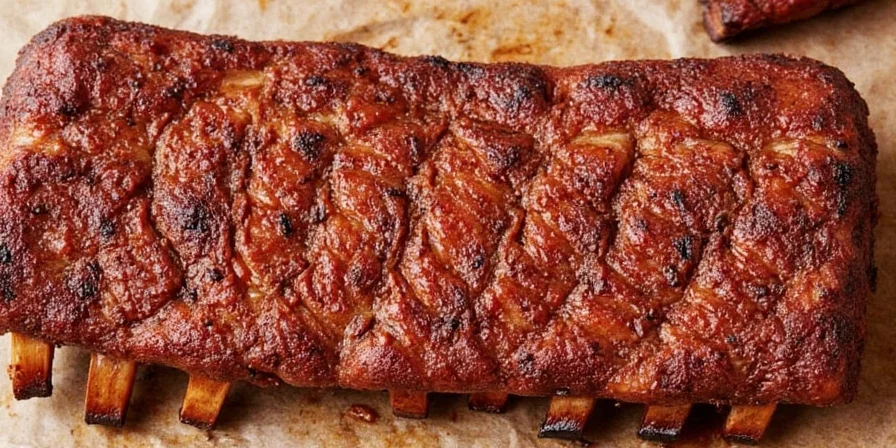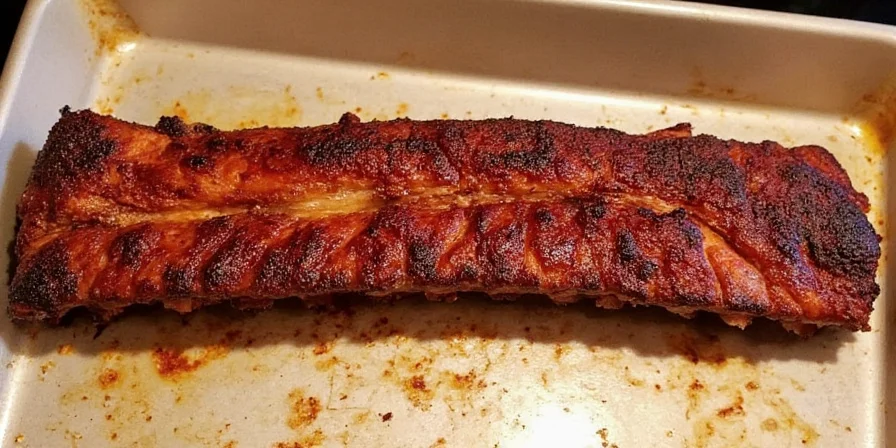Looking for the perfect oven-baked beef ribs? Start with these essential fundamentals: Preheat your oven to 275°F (135°C), remove the membrane from the bone side, apply a simple 3-ingredient rub (salt, pepper, garlic powder), and bake for 3-4 hours until the internal temperature reaches 203°F (95°C). Wrap in parchment paper at 165°F internal temperature for optimal moisture retention. This proven method delivers consistently tender, flavorful ribs with minimal effort—ideal for beginners and experts alike.

🍖 The Complete Guide to Oven-Baked Beef Ribs: Simple Method + Advanced Flavor Techniques
Whether you're a weeknight dinner chef or hosting a weekend barbecue, mastering oven-baked beef ribs starts with understanding both the basic process and advanced flavor optimization. This comprehensive guide combines tested cooking protocols with food science principles to help you achieve restaurant-quality results at home—every time.
⏱️ How Long to Cook Beef Ribs in the Oven (Quick Reference)
- Temperature: 275°F (135°C) for best results
- Time: 3-4 hours (until internal temp reaches 203°F/95°C)
- Prep: Remove membrane, apply rub, rest 30 minutes before baking
- Resting: 15 minutes minimum after cooking
The Essential Oven-Baked Beef Ribs Method (Step-by-Step)
Follow these five critical steps for foolproof beef ribs:
- Prep the ribs: Remove the membrane from the bone side using a butter knife and paper towel for grip. This allows smoke and spices to penetrate.
- Dry brine (optional but recommended): Apply 1 tsp kosher salt per pound and refrigerate uncovered for 1-12 hours.
- Apply the foundation rub: Use equal parts salt, coarse black pepper, and garlic powder before adding specialty spices.
- Bake low and slow: Place ribs bone-side down on a wire rack over a baking sheet at 275°F for 3-4 hours.
- Wrap and finish: When internal temperature hits 165°F, wrap in parchment paper and return to oven until reaching 203°F.
Optimal Spice Storage for Maximum Flavor Impact
Spice degradation begins immediately after grinding, directly affecting your rib's flavor profile. Light exposure degrades paprika's capsanthin within 6 months in clear containers, while cumin's cuminaldehyde diminishes 40% faster in plastic versus glass. Proper storage preserves volatile compounds essential for complex rib flavor.
Practical Tip: Store spices in mason jars in a dark cabinet—this maintains 90-95% potency after 12 months compared to 55-65% in plastic bags.
| Storage Method | Flavor Potency After 12 Months | Best For | Cost |
|---|---|---|---|
| Plastic Bags | 55-65% | Spices used within 3 months | $ |
| Glass Jars (Cupboard) | 75-85% | Everyday cooking spices | $$ |
| Mason Jars (Dark Cabinet) | 90-95% | Premium spices for special occasions | $$$ |
The Perfect Beef Rib Rub Formula (Simple + Advanced Options)
Start with this foundational 3-ingredient rub that works for all skill levels before advancing to specialty blends:
Basic Beef Rib Rub (For 3-4 Ribs)
- 2 tbsp coarse kosher salt
- 2 tbsp coarse black pepper
- 1 tbsp garlic powder
Advanced Flavor-Enhanced Rub
- 3 tbsp brown sugar (accelerates Maillard reaction)
- 2 tbsp smoked paprika (provides stable color compounds)
- 1 tbsp garlic powder (releases allicin precursors)
- 1 tbsp onion powder (enhances sulfur-based umami)
- 1 tsp chili powder (capsaicin binds to fat molecules)
- 1 tsp black pepper (piperine improves compound solubility)
- ½ tsp cayenne (optional heat modulation)
Why Toasting Spices Transforms Rib Flavor (And How to Do It Right)
Dry toasting transforms spice chemistry—warming cumin releases 30% more cuminaldehyde, while paprika develops deeper flavor compounds at 175°F (79°C). But exceeding 200°F (93°C) causes rapid degradation of key terpenes.
Precision Toasting Protocol for Home Cooks:
- Use medium-low heat (325°F/163°C surface temperature)
- Stir continuously for 90-120 seconds
- Remove at first aroma release (prevents compound burn-off)
- Cool completely before applying to ribs (halts thermal reactions)

Room-Temperature Infusion: The Secret to Deeper Flavor Penetration
Microwave heating risks thermal degradation of delicate spice compounds. Instead, combine spices with 2 tbsp oil and 1 tbsp vinegar, then allow 10-15 minutes at room temperature. This enables molecular diffusion without damaging heat-sensitive compounds like eugenol in cloves.
Simple Infusion Method for Beginners:
- 2 tbsp high-smoke point oil (avocado or grapeseed)
- 1 tbsp apple cider vinegar (pH 3.0-3.5 ideal for protein interaction)
- Freshly toasted spice blend
Pro Tip: Room-temperature infusion maintains volatile compounds while allowing vinegar's acidity to slightly swell meat fibers for deeper penetration—critical for achieving restaurant-quality flavor depth.
Coffee Grounds: The Unexpected Beef Rib Flavor Catalyst
Coffee's chlorogenic acids catalyze Maillard reactions at lower temperatures, creating complex melanoidins that enhance beef's natural umami. Used grounds provide concentrated compounds without liquid dilution.

Easy Coffee Rub Integration:
- Finely grind used coffee grounds
- Mix with 1:1 ratio brown sugar for balanced caramelization
- Apply 15 minutes before baking to allow acid activation
Oven-Baking Science: What Happens Between 165°F and 203°F
Understanding the temperature journey explains why precise timing matters:
- 165°F (74°C): Collagen begins breaking down, but membrane still blocks flavor penetration (time to wrap)
- 180°F (82°C): Fat renders slowly, carrying flavor compounds deeper into meat fibers
- 203°F (95°C): Collagen fully converts to gelatin, creating that signature fall-off-the-bone texture
5 Common Beef Rib Mistakes (And How to Avoid Them)
- Mistake: Skipping membrane removal Solution: Use a butter knife to lift edge, then grip with paper towel and peel off
- Mistake: Baking at too high temperature Solution: Never exceed 300°F (149°C) for beef ribs—275°F is ideal
- Mistake: Wrapping too early Solution: Wait until internal temperature reaches 165°F before wrapping
- Mistake: Cutting immediately after cooking Solution: Rest for 15 minutes minimum to allow myoglobin reabsorption
- Mistake: Using liquid smoke Solution: Toasted spices create more authentic smoke flavor without artificial taste
Frequently Asked Questions
How long to cook beef ribs at 275°F?
Beef ribs require 3-4 hours at 275°F until the internal temperature reaches 203°F (95°C). The exact time depends on rib thickness—check with a meat thermometer starting at 3 hours. Wrapping in parchment paper at 165°F internal temperature improves moisture retention without steaming the meat.
Should I wrap beef ribs in foil or parchment?
Parchment paper is superior to foil for wrapping beef ribs. It allows some moisture exchange while retaining heat, preventing the 'steamed' texture that foil creates. Wrap when internal temperature reaches 165°F, then return to oven until reaching 203°F for optimal collagen conversion without compromising bark formation.
Why are my oven-baked beef ribs tough?
Beef ribs become tough when removed before collagen fully converts to gelatin at 203°F (95°C). Unlike pork ribs, beef ribs require higher final temperatures. Also check if you removed the membrane—it blocks flavor penetration and prevents proper texture development. Always use a meat thermometer rather than relying solely on time.
What's the best rub for beginners?
Start with a simple 3-ingredient rub: equal parts coarse salt, black pepper, and garlic powder. This creates a perfect flavor foundation without overwhelming complexity. Apply generously, let rest 30 minutes, then bake at 275°F. Once comfortable with basics, add brown sugar and smoked paprika for enhanced caramelization and depth.










 浙公网安备
33010002000092号
浙公网安备
33010002000092号 浙B2-20120091-4
浙B2-20120091-4